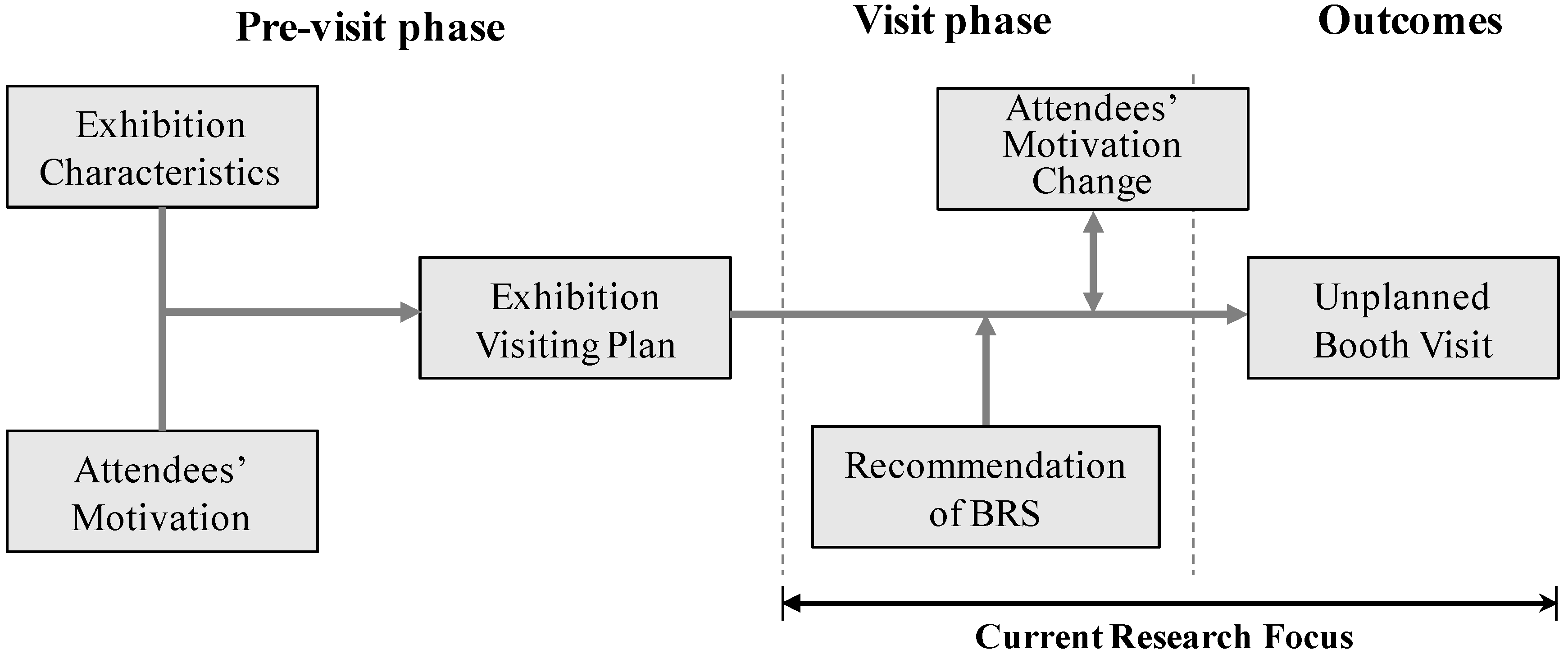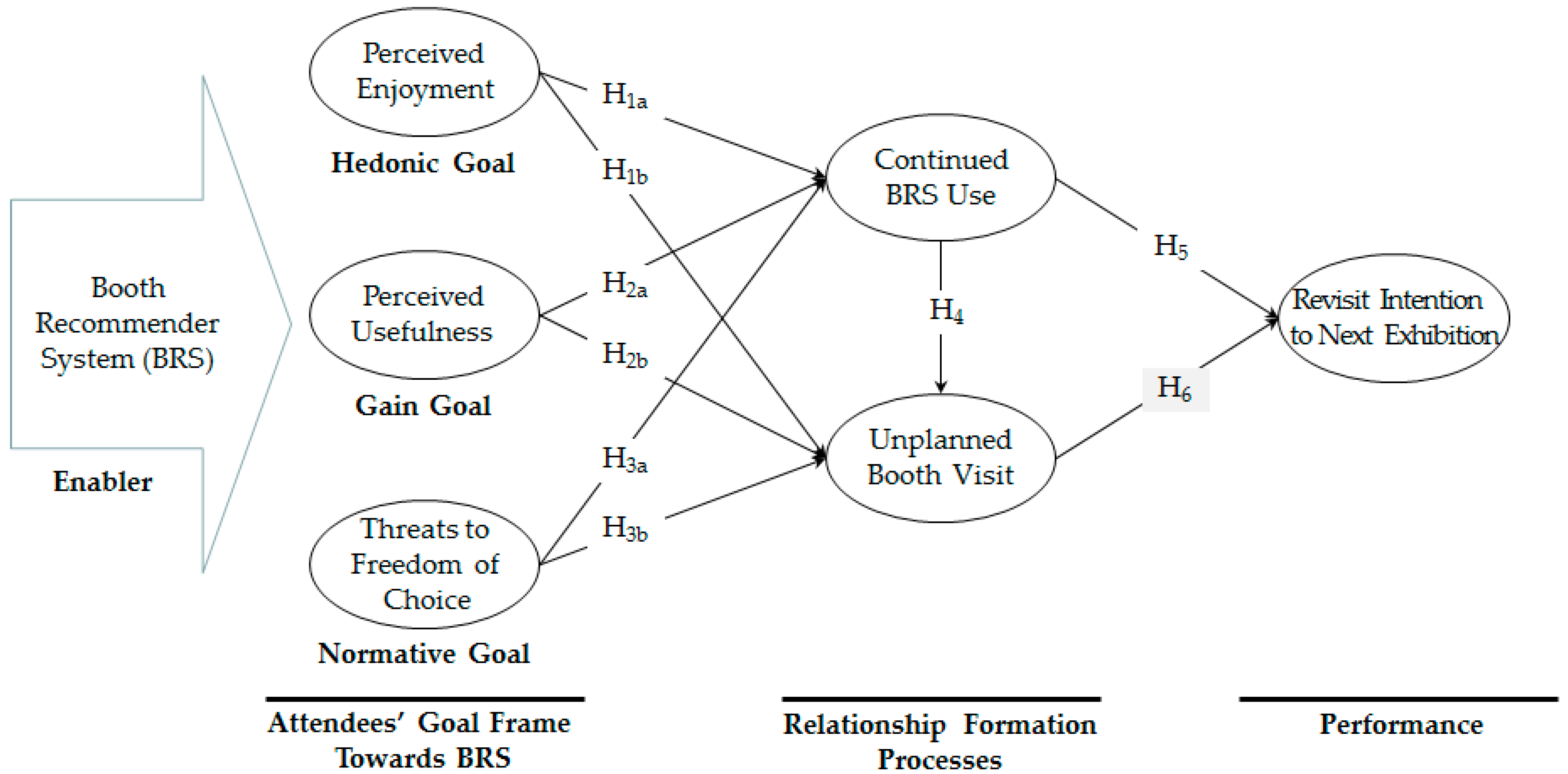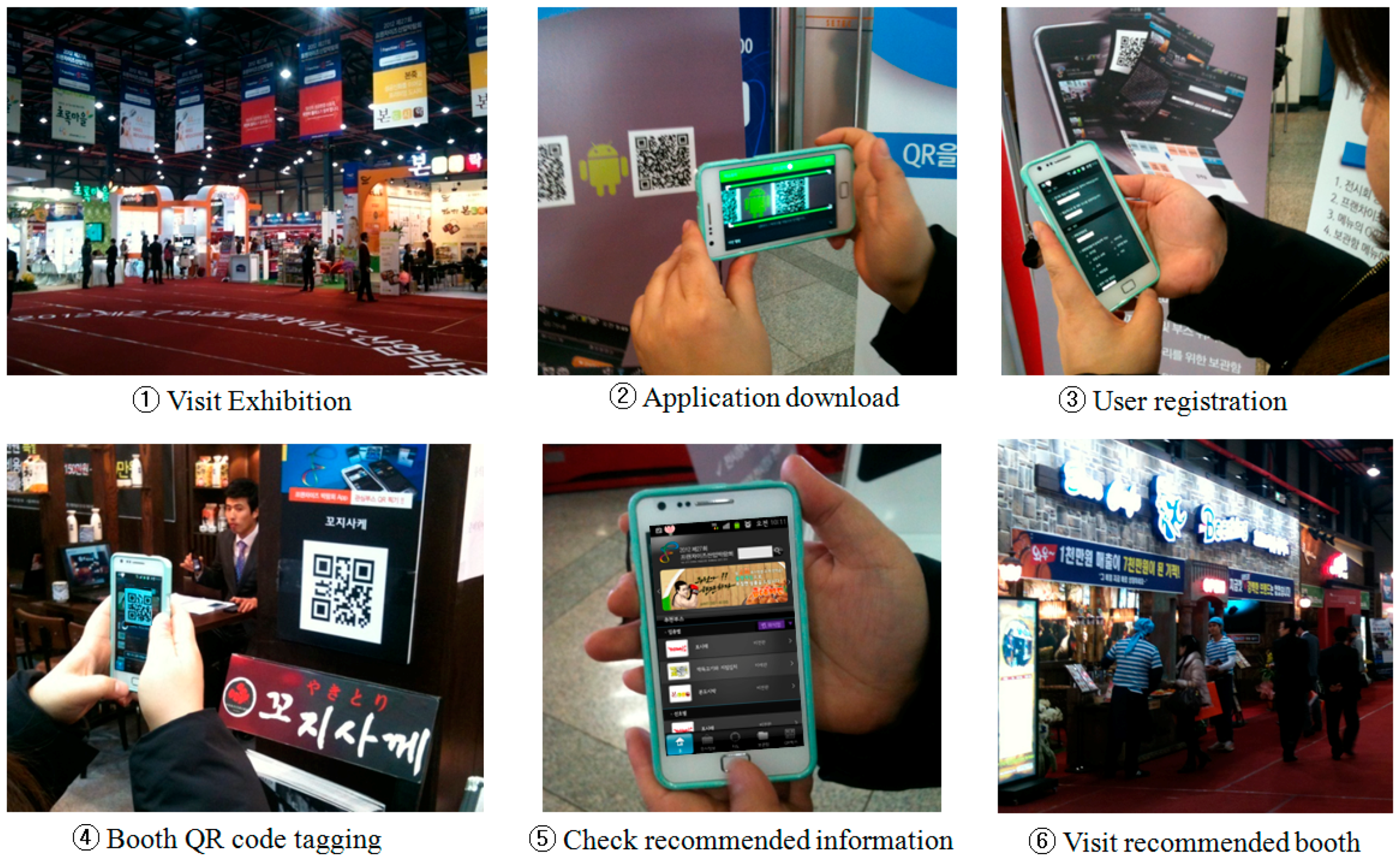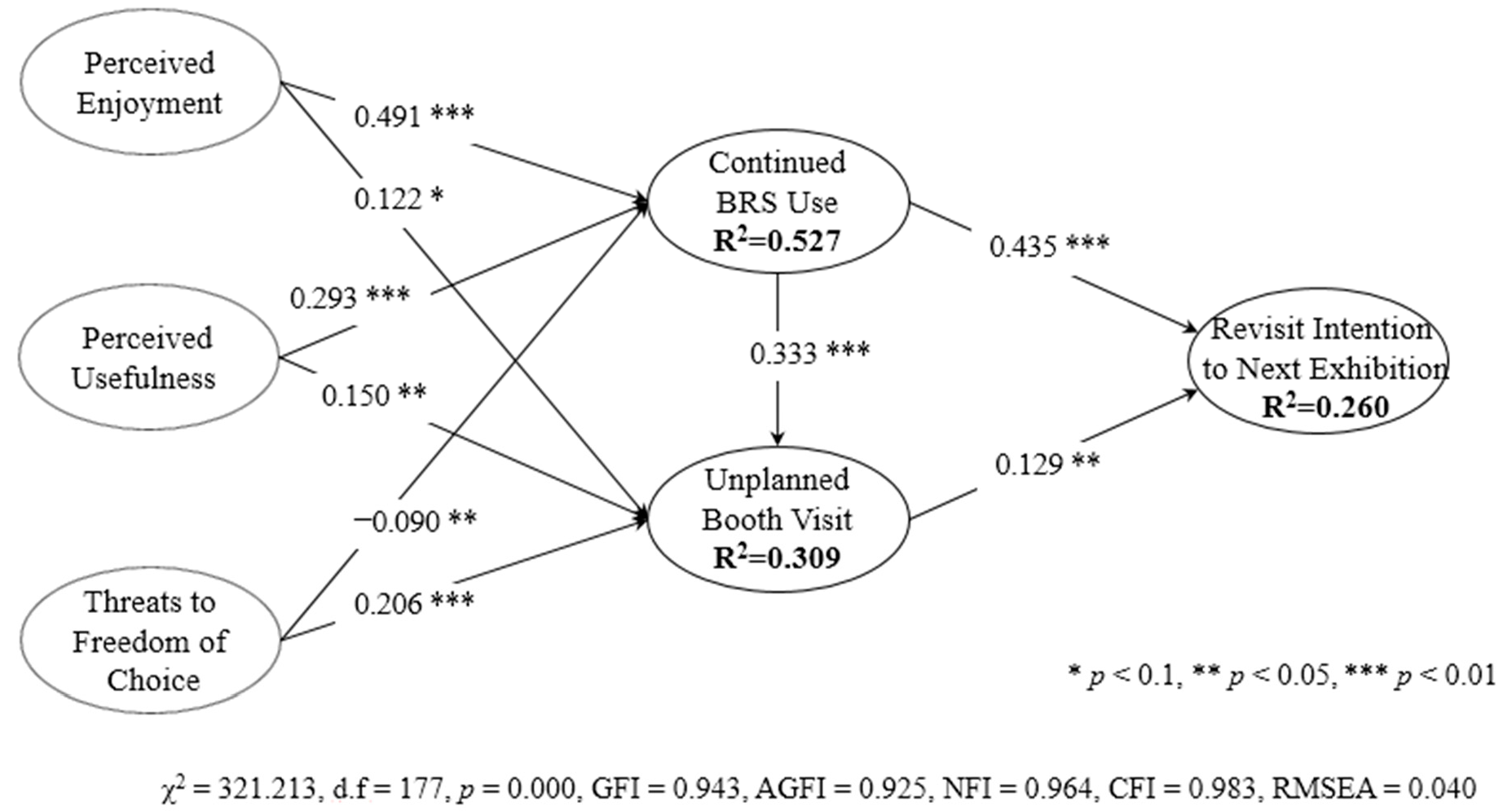Assessing the Impact of Mobile Technology on Exhibition Attendees’ Unplanned Booth Visit Behaviour
Abstract
:1. Introduction
2. Theoretical Background
2.1. Goal Framing Theory
2.2. Unplanned Behaviour Theory
3. Research Model and Hypotheses
3.1. Perceived Enjoyment
3.2. Perceived Usefulness
3.3. Threats to Freedom of Choice
3.4. Continued BRS Use, Unplanned Booth Visits, and Revisit Intentions at Exhibitions
4. Research Methodology
4.1. Instrument Development
4.2. Data Collection
5. Data Analysis and Results
5.1. Confirmatory Factor Analysis
5.2. Hypothesis Testing
6. Discussion and Conclusions
Acknowledgments
Author Contributions
Conflicts of Interest
References
- Kwon, S.J.; Chung, N. The moderating effects of psychological reactance and product involvement on online shopping recommendation mechanisms based on a causal map. Electron. Commer. Res. Appl. 2010, 9, 522–536. [Google Scholar] [CrossRef]
- Huerta, E.; Glandon, T.; Petrides, Y. Framing, decision-aid systems, and culture: Exploring influences on fraud investigations. Int. J. Account. Inf. Syst. 2012, 13, 316–333. [Google Scholar] [CrossRef]
- Clee, M.A.; Wicklund, R.A. Consumer behavior and psychological reactance. J. Consum. Res. 1980, 6, 389–405. [Google Scholar] [CrossRef]
- Lindenberg, S.; Steg, L. Normative, gain and hedonic goal frames guiding environmental behaviour. J. Soc. Issues 2007, 63, 117–137. [Google Scholar] [CrossRef]
- Park, J.; Lennon, S.J. Psychological and environmental antecedents of impulse buying tendency in the multichannel shopping context. J. Consum. Market. 2006, 23, 56–66. [Google Scholar] [CrossRef]
- Pollay, R.W. Customer impulse purchasing behavior: A re-examination. J. Market. Res. 1968, 5, 323–325. [Google Scholar] [CrossRef]
- Mandl, M.; Felfernig, A.; Teppan, E.; Schubert, M. Consumer decision making in knowledge-based recommendation. J. Intell. Inf. Syst. 2011, 3, 1–22. [Google Scholar] [CrossRef]
- Lindenberg, S. Social rationality versus rational egoism. In Handbook of Sociological Theory; Turner, J., Ed.; Kluwer Academic/Plenum: New York, NY, USA, 2001; pp. 635–668. [Google Scholar]
- Taylor, S.; Todd, P.A. Understanding information technology usage: A test of competing models. Inf. Syst. Res. 1995, 6, 144–176. [Google Scholar] [CrossRef]
- Ajzen, I.; Fishbein, M. Understanding Attitudes and Predicting Social Behavior; Prentice-Hall: Englewood Cliffs, NJ, USA, 1980. [Google Scholar]
- Hampton, C. Determinants of reliance: An empirical test of the theory of technology dominance. Int. J. Account. Inf. Syst. 2005, 6, 217–240. [Google Scholar] [CrossRef]
- Hostler, E.R.; Yoon, V.Y.; Guo, Z.; Guimaraes, T.; Forgionne, G. Assessing the impact of recommender agents on on-line consumer unplanned purchase behavior. Inf. Manag. 2011, 48, 336–343. [Google Scholar] [CrossRef]
- Kah, J.A.; Lee, S.H. Beyond adoption of travel technology: Its application to unplanned travel behaviors. J. Travel Tour. Market. 2014, 31, 667–680. [Google Scholar] [CrossRef]
- Liobikienė, G.; Juknys, R. The role of values, environmental risk perception, awareness of consequences, and willingness to assume responsibility for environmentally-friendly behaviour: The Lithuanian case. J. Clean. Prod. 2016, 112, 3413–3422. [Google Scholar] [CrossRef]
- Hwang, Y.H.; Fesenmaier, D.R. Unplanned tourist attraction visits by travellers. Tour. Geogr. 2011, 13, 398–416. [Google Scholar] [CrossRef]
- Hwang, Y.H. A theory of unplanned travel decisions: Implications for modeling on-the-go travelers. Inform. Tech. Tourism. 2010, 12, 283–296. [Google Scholar] [CrossRef]
- Beatty, S.E.; Ferrell, M.E. Impulse buying: Modelling its precursors. J. Retail. 1998, 74, 169–191. [Google Scholar] [CrossRef]
- Chen, G.; Mathieu, J.E. Goal orientation dispositions and performance trajectories: The roles of supplementary and complementary situational inducements. Organ. Behav. Hum. Decis. Process 2008, 106, 21–38. [Google Scholar] [CrossRef]
- Krishnamurthy, P.; Carter, P.; Blair, E. Attribute framing and goal framing effects in health decisions. Organ. Behav. Hum. Decis. Process 2001, 85, 382–399. [Google Scholar] [CrossRef] [PubMed]
- Sun, H.; Zhang, P. Causal relationships between perceived enjoyment and perceived ease of use: An alternative approach. J. Assoc. Inf. Syst. 2006, 7, 618–645. [Google Scholar]
- Kim, B.; Han, I. The role of utilitarian and hedonic values and their antecedents in a mobile data service environment. Expert Syst. Appl. 2011, 38, 2311–2318. [Google Scholar] [CrossRef]
- Foss, N.J.; Lindenberg, S. Microfoundations for strategy: A goal-framing perspective on the drivers of value creation. Acad. Manag. Perspect. 2013, 27, 85–102. [Google Scholar] [CrossRef]
- Heijden, H. User acceptance of hedonic information systems. MIS Q. 2004, 28, 695–704. [Google Scholar]
- Davis, F.D. Perceived usefulness, perceived ease of use, and user acceptanceof information technology. MIS Q. 1989, 13, 319–342. [Google Scholar] [CrossRef]
- Kolm, S.C. Rational normative economics vs. ‘social welfare’ and ‘social choice’. Eur. Econ. Rev. 1994, 38, 721–730. [Google Scholar] [CrossRef]
- Chung, N.; Koo, C.; Kim, J.K. Extrinsic and intrinsic motivation for using a booth recommender system service on exhibition attendees’ unplanned visit behavior. Comput. Hum. Behav. 2014, 30, 59–68. [Google Scholar] [CrossRef]
- March, R.; Woodside, A.G. Testing theory of planned versus realized tourism behavior. Ann. Tour. Res. 2005, 32, 905–924. [Google Scholar] [CrossRef]
- Lee, G.; Lee, W.J. Psychological reactance to online recommendation services. Inf. Manag. 2009, 46, 448–452. [Google Scholar] [CrossRef]
- Abratt, R.; Goodey, S.D. Unplanned buying and in-store stimuli in supermarkets. Manag. Decis. Econ. 1990, 11, 111–121. [Google Scholar] [CrossRef]
- Davis, F.; Bagozzi, R.P.; Warshaw, P.R. Extrinsic and intrinsic motivation to use computers in the workplace. J. Appl. Soc. Psychol. 1992, 22, 1111–1132. [Google Scholar] [CrossRef]
- Parboteeah, D.V.; Valacich, J.S.; Wells, J.D. The influence of website characteristics on a consumer’s urge to buy impulsively. Inf. Syst. Res. 2009, 20, 60–78. [Google Scholar] [CrossRef]
- Bressolles, G.; Durrieu, F.; Giraud, M. The impact of electronic service quality’s dimensions on customer satisfaction and buying impulse. J. Cust. Behav. 2007, 6, 37–56. [Google Scholar] [CrossRef]
- Bhattacherjee, A.; Sanford, C. Influence processes for information technology acceptance: An elaboration likelihood model. MIS Q. 2006, 30, 805–825. [Google Scholar]
- Limayem, M.; Cheung, C.M.K. Understanding information systems continuance: The case of internet-based learning technologies. Inf. Manag. 2008, 45, 227–232. [Google Scholar] [CrossRef]
- Harmancioglu, N.; Finney, R.Z.; Joseph, M. Impulse purchases of new products: An empirical analysis. J. Prod. Brand Manag. 2009, 18, 27–37. [Google Scholar] [CrossRef]
- Chang, C.C.; Tseng, A.H. The post-purchase communication strategies for supporting online impulse buying. Comput. Hum. Behav. 2014, 39, 393–403. [Google Scholar] [CrossRef]
- Pirog, S.F.; Roberts, J.A. Personality and credit card misuse among college students: The mediating role of impulsiveness. J. Market. Theory Pract. 2007, 15, 65–77. [Google Scholar] [CrossRef]
- Rook, D.W.; Fisher, R.J. Normative influences on impulsive buying behavior. J. Consum. Res. 1995, 22, 305–313. [Google Scholar] [CrossRef]
- Dittmar, H.; Beattie, J.; Friese, S. Objects, decision considerations and self-image in men’s and women’s impulse purchases. Acta Psychol. 1996, 93, 187–206. [Google Scholar] [CrossRef]
- Hausman, A. A multi-method investigation of consumer motivations in impulse buying behavior. J. Consum. Market. 2000, 17, 403–426. [Google Scholar] [CrossRef]
- Hong, S.; Tam, K.Y. Understanding the adoption of multipurpose information appliances: The case of mobile data services. Inf. Syst. Res. 2006, 17, 162–179. [Google Scholar] [CrossRef]
- Severt, D.; Wang, Y.; Chen, P.J.; Breiter, D. Examining the motivation, perceived performance, and behavioral intentions of convention attendees: Evidence from a regional conference. Tour. Manag. 2007, 28, 399–408. [Google Scholar] [CrossRef]
- Hair, J.F., Jr.; Black, W.C.; Babin, B.J.; Anderson, R.E.; Tatham, R.L. Multivariate Data Analysis, 6th ed.; Pearson Prentice Hall: Upper Saddle River, NJ, USA, 2006. [Google Scholar]
- Kline, R.B. Principles and Practice of Structural Equation Modeling; Guilford: New York, NY, USA, 2011. [Google Scholar]
- Anderson, J.C.; Gerbing, D.W. Assumptions and comparative strengths of the two-step approach. Sociol. Methods Res. 1992, 23, 321–333. [Google Scholar] [CrossRef]
- Gefen, D.; Straub, D.W.; Boudreau, M. Structural equation modeling and regression: Guidelines for research practice. Commun. AIS 2000, 4, 2–76. [Google Scholar]
- Fornell, C.; Larcker, D.F. Evaluating structural equation models with unobservable variables and measurement error. J. Market. Res. 1981, 18, 39–50. [Google Scholar] [CrossRef]
- Solo. Solo Launcher and Alibaba’s Alohar Mobile Build the World’s First Contextually Intelligent Launcher. PR News. 15 May 2015. Available online: http://www.prnewswire.com/news-releases/solo-launcher-and-alibabas-alohar-mobile-build-the-worlds-first-contextually-intelligent-launcher-300084052.html (accessed on 25 April 2017).
- O’Neill, K. Artbot Engineers the Discovery of Art. MIT News. 13 May 2015. Available online: http://news.mit.edu/2015/artbot-engineers-discovery-art-0513 (accessed on 20 April 2017).




| Constructs and Variables | Loadings | CR b | AVE c | α | |
|---|---|---|---|---|---|
| Perceived Enjoyment | 1. I had fun using the booth Recommender service. | 0.894 | 0.927 | 0.761 | 0.926 |
| 2. The booth Recommender service was entertaining for me. | 0.901 | ||||
| 3. I enjoyed the booth Recommender service. | 0.888 | ||||
| 4. The booth Recommender service was not boring. | 0.802 | ||||
| Perceived Usefulness | 1. Using the booth Recommender service enables me to find a desired booth more quickly. | 0.926 | 0.905 | 0.762 | 0.901 |
| 2. Using the booth Recommender service enables me to find a desired booth more easily. | 0.898 | ||||
| 3. Using the booth Recommender service is helpful for the show experience. | 0.788 | ||||
| Threats to Freedom of Choice | 1. The booth Recommender service limits me in finding an exhibition booth. | 0.780 | 0.903 | 0.758 | 0.901 |
| 2. The booth Recommender service makes it inconvenient for me to find an exhibition booth. | 0.943 | ||||
| 3. The booth Recommender service bothers me in finding the exhibition booth. | 0.881 | ||||
| Continued BRS Use | 1. I continuously used the booth Recommender service. | 0.872 | 0.911 | 0.773 | 0.909 |
| 2. The booth Recommender service continuously helped me to find booths easily. | 0.920 | ||||
| 3. The booth Recommender service continuously fulfilled my expectations. | 0.844 | ||||
| Unplanned Booth Visits | 1. I visited an unplanned booth through the booth Recommender service. | 0.679 | 0.878 | 0.645 | 0.874 |
| 2. I spontaneously visited a booth through the booth Recommender service. | 0.867 | ||||
| 3. I visited a booth without thinking through the booth Recommender service. | 0.853 | ||||
| 4. I visited a booth on the spur of the moment due to the booth Recommender service. | 0.799 | ||||
| Revisit Intention to Exhibition | 1. I will attend the franchise exhibition again. | 0.908 | 0.945 | 0.811 | 0.944 |
| 2. I am planning to visit the franchise exhibition frequently in the future. | 0.922 | ||||
| 3. I will continue to visit the franchise exhibition in the future. | 0.930 | ||||
| 4. I would recommend the franchise exhibition to others. | 0.840 | ||||
| Construct | Correlation of Constructs | Mean | S.D. | |||||
|---|---|---|---|---|---|---|---|---|
| 1 | 2 | 3 | 4 | 5 | 6 | |||
| 1. Perceived enjoyment | 0.872 | 4.921 | 1.126 | |||||
| 2. Perceived usefulness | 0.613 ** | 0.873 | 5.167 | 1.179 | ||||
| 3. Threats to freedom of choice | 0.008 | −0.090 * | 0.871 | 3.504 | 1.418 | |||
| 4. Continued BRS use | 0.405 ** | 0.385 ** | 0.139 ** | 0.879 | 5.053 | 1.106 | ||
| 5. Unplanned booth visits | 0.632 ** | 0.589 ** | −0.090 * | 0.439 ** | 0.803 | 4.745 | 1.178 | |
| 6. Revisit intention to exhibition | 0.384 ** | 0.425 ** | −0.114 * | 0.315 ** | 0.456 ** | 0.901 | 5.658 | 1.094 |
| Hypothesis | Path | Estimates (t-Value) | Results |
|---|---|---|---|
| Hypothesis 1a | Perceived enjoyment → Continued BRS use | 0.491(9.613) | Supported |
| Hypothesis 1b | Perceived enjoyment → Unplanned booth visit | 0.122(1.803) | Supported |
| Hypothesis 2a | Perceived usefulness → Continued BRS use | 0.293(5.767) | Supported |
| Hypothesis 2b | Perceived usefulness → Unplanned booth visit | 0.150(2.407) | Supported |
| Hypothesis 3a | Threats to freedom of choice → Continued BRS use | −0.090(−2.513) | Supported |
| Hypothesis 3b | Threats to freedom of choice → Unplanned booth visit | 0.206(4.646) | Supported |
| Hypothesis 4 | Continued BRS use → Unplanned booth visit | 0.333(4.890) | Supported |
| Hypothesis 6 | Continued BRS use → Revisit intention to exhibition | 0.435(8.443) | Supported |
| Hypothesis 6 | Unplanned booth visit → Revisit intention to exhibition | 0.129(2.560) | Supported |
© 2017 by the authors. Licensee MDPI, Basel, Switzerland. This article is an open access article distributed under the terms and conditions of the Creative Commons Attribution (CC BY) license (http://creativecommons.org/licenses/by/4.0/).
Share and Cite
Chung, N.; Koo, C.; Lee, K. Assessing the Impact of Mobile Technology on Exhibition Attendees’ Unplanned Booth Visit Behaviour. Sustainability 2017, 9, 884. https://doi.org/10.3390/su9060884
Chung N, Koo C, Lee K. Assessing the Impact of Mobile Technology on Exhibition Attendees’ Unplanned Booth Visit Behaviour. Sustainability. 2017; 9(6):884. https://doi.org/10.3390/su9060884
Chicago/Turabian StyleChung, Namho, Chulmo Koo, and Kyungmin Lee. 2017. "Assessing the Impact of Mobile Technology on Exhibition Attendees’ Unplanned Booth Visit Behaviour" Sustainability 9, no. 6: 884. https://doi.org/10.3390/su9060884







